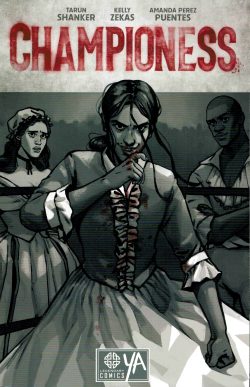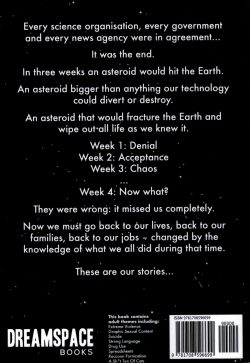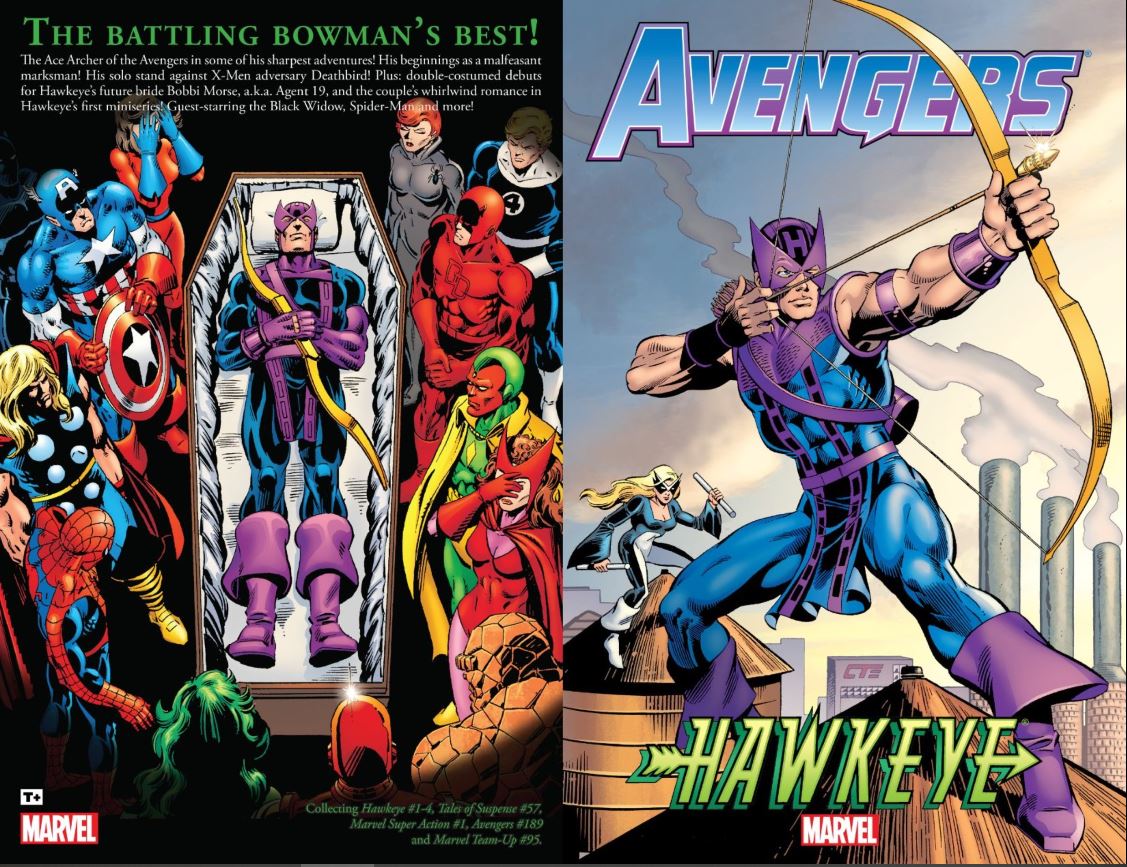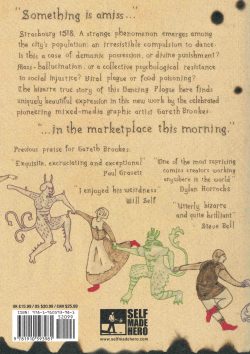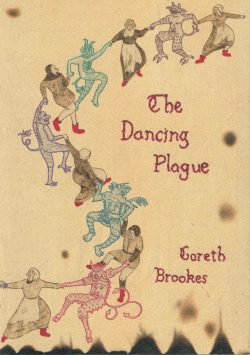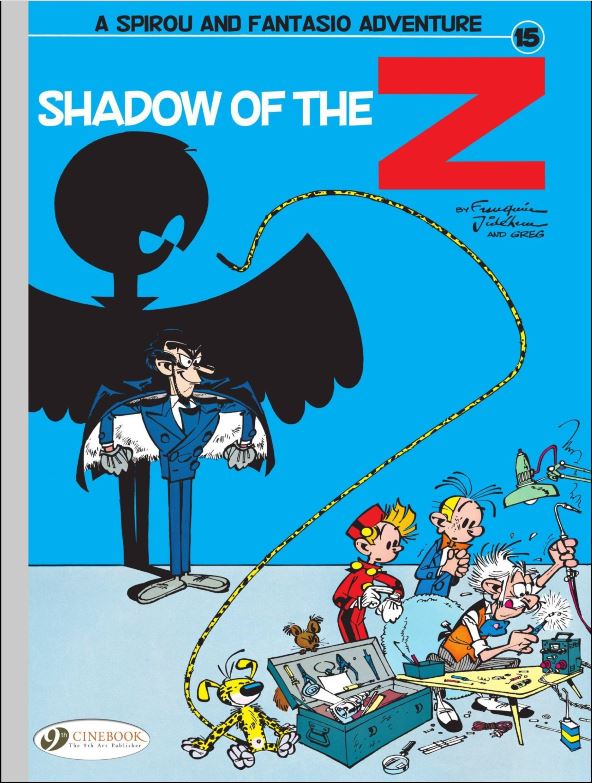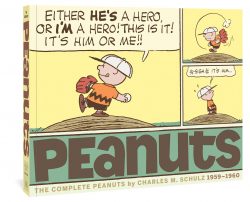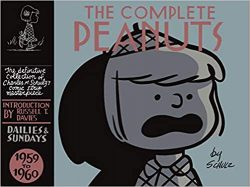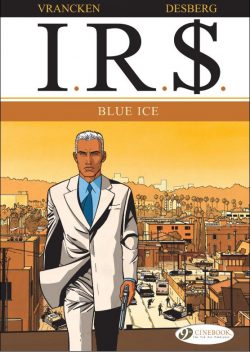
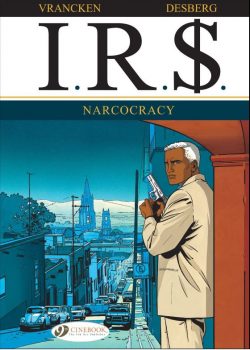
By Vranken & Desberg; coloured by Coquelicot and translated by Luke Spear (Cinebook)
ISBN: 978-1-905460-74-8 (Album PB)
As I’ve perpetually stated, the most appealing aspect of European comics is the sheer breadth of genres, styles and age-ranges their efforts address and their huge readerships support. Thus, this quirky exceedingly readable, all-action Franco-Belgian thriller-series with a tantalising twist offering a deliciously different spin on the tried-and-true trope of driven mystery-man superspy.
The unlikely champion of these sagas is a civil servant with the US government, which once upon a time started employing super-cool, infallibly effective special agents to go after the type of tax-dodger totally beyond the reach of the law. Maybe one day, fact will pilfer from fiction and perhaps every nation will have one…
Belgian writer Stephen Desberg is one of France’s most popular comics authors. He was born in Brussels in 1954, son of an American lawyer (the European distribution agent for Metro-Goldwyn Mayer) and a French mother. Stephen began studying law at Université Libre de Bruxelles but dropped out to follow a winding path into the comics biz.
He began with plots and eventually scripts for Will (Willy Maltaite) on Tif et Tondu in Le Journal de Spirou, growing into a reliable jobbing scribe on established strips for younger readers before launching his own (the Stéphane Colman illustrated) Billy the Cat (a funny animal strip, not the DC Thomson superhero series).
Thereafter came 421 with Eric Maltaite, Arkel (Marc Hardy), Jimmy Tousseul (with Daniel Desorgher) and many others. During the 1980s he gradually redirected his efforts to material for older readerships (such as The Garden of Desire) and in 1999 created contemporary thriller IR$. Historical conspiracy thriller Le Scorpion joined his catalogue of hits a year later.
Bernard Vranken was an award-winning artist by the time he was fifteen. A year later he was working for Le Journal deTintin. Whilst studying architecture at Saint-Luc, he took some comics courses by legendary illustrator Eddy Paape at St. Gilles and his true career-path was set.
Vranken was crafting short stories for A Suivre when he met Desberg. In 1996 they collaborated for the first time on epic romance Le Sang Noir. Three years later they traded love for money with I.R.$.…
The premise is simple and delicious, and Cinebook’s second translated English edition from 2009 once again doubles the bang for your buck by combining third and fourth European albums – Blue Ice and Narcocratie – into one compelling compilation.
Blue Ice (originally released in 2001) opens with stylish American bean-counter Larry B. Max relaxing in his sumptuous home. The quiet start offers the observant reader a few hints into Larry’s past – and motivations – before he renews his odd, long-distance, anonymous relationship with favourite chat-line girl Gloria Paradise.
Larry hates complications in his life but there’s just something about her voice and attitude…
A little later he attends a piano rehearsal and promises his little sister he’ll be there for the recital on Friday. It’s just asking for trouble…
Meanwhile downtown, three very bad men are meeting excessively violent ends while Los Angeles airport sees an American passenger from Mexico trigger a wave of security alerts. Typically, though, just too late for the inattentive security staff to do more than watch him spectacularly disappear into the city, leaving two dead agents behind…
Later at DEA HQ, a high-level meeting of numerous Federal agencies convenes to discuss Ryan Ricks. During his tour in Vietnam, Ricks began managing the money of his platoon-mates, subsequently using it to make a killing on the Stock Exchange.
Slightly wounded, he then shipped out for home to be eagerly pursued by finance houses who saw his unique gift for using money and making it. Ricks settled in at a major tobacco company and started creating wealth…
Nobody noticed – or perhaps cared – that Ricks was making side-deals, nor that being utterly amoral, he went where the money was to be easily found: terrorist nations…
When the IRS found out he was using dirty cash to make the company more money – and making himself fabulously rich at the same time – Ryan was fired. He claimed to have no understanding of why terrorist money was bad, while profits from giving people cancer was good…
Ricks was a man ahead of his time. Even before the Cold War ended, he was saying New Capitalism would be beyond any laws, and consequently pursued that philosophy to its logical extreme. Specialising in creating off-shore accounts, he became the world’s greatest money-launderer, devising an international network for tax evasion.
That’s when Larry Max first encountered him, but the wily finance wizard simply vanished, with a swathe of alphabetised American agencies waiting for him to turn up ever since…
Now twelve years later he’s back in the USA, so scores can be settled and pride regained. However, some bigwigs are unconvinced. With so many major players in the Monterrey Cartel gunned down in the street, the feds would rather concentrate on a clearly-brewing turf war than some nebulous cash-converter.
Late-arriving Larry is “only†a tax collector, not a true cop, but he can’t help wondering why they all think the events are unconnected…
Consulting his own researches, Mr Max coolly exposes a traitor in the cross-agency conclave and foresees things becoming extremely dramatic for the Monterrey Cartel, but is fobbed off with only two agents to assist him. Hanson‘s shadowy spook-show has access to covert satellite surveillance and phone monitoring whereas Ella Hidalgo of DEA is a stone killer everyone calls “Blue Iceâ€. She’s going to be useful once lead starts flying…
Across the border, the prediction has already come true. Aged, untouchable head of the clan Dion Monterrey has begun cleaning house, eradicating all dissent before heading to LA for the most important meeting of his life…
Aided by cutting-edge covert spy technology, the hunt for Ricks moves into high gear and it’s not long before Larry and Hildalgo are quietly closing in. Then, a second traitor inadvertently tips his hand too soon and the astounded IRS agent has the key piece of information he needs to complete the puzzle…
Ultimate harbinger of unfettered Free Enterprise, Ricks has returned to America because he’s acting as facilitator for the deal of the ages: selling off one of world’s largest drugs cartels…
Larry is not satisfied. The facts simply don’t add up, and as he ponders the mystery and sweats the details, Ricks is closing the deal and Dion is ensuring there’s no one left to contest the sale…
With every party understandably edgy, the final handover is set to occur on the roof of a luxury shopping mall. While fanatical Ricks describes the way business will be conducted in the until-now inefficiently managed, under-exploited market of modern coke consumption, the good guys quietly close in but they have grossly underestimated the guile and paranoia of their targets. Soon the entire scene is a hellish firefight of lethal proportions…
As ever, the end result is a pile of bodies, massive collateral damage and Ricks a ghost in the wind, but this time Larry is hot on his tail…
Without pause for breath the story concludes in Narcocracy as Max arrives in Tijuana, just as the next move in Ricks’ grand strategy goes live: acquisition and expansion…
Before dawn breaks in the seedy hellhole, many of the proud cartel hold-outs opposing the new order are gone and the game plan is clear. It’s not consolidation or merger Ricks and his mystery backers have in mind for the already lucrative drug trade, it’s a hostile takeover…
The only fly in the ointment is a certain white-haired American implacably following the money magician everywhere: someone proving utterly impossible to kill…
Help comes from a most unexpected quarter as the Mexican Federal Bureau of Narcotics picks up the taxman, claiming he’s about to blow a massive sting operation. Larry keeps his thoughts to himself when meeting the country’s top brass to warn them of Rick’s current ambitious activities. After all, money talks; he’s in a country notorious for corruption and the wizard of wealth-creation has more cash than any other crook in the world…
Soon Max is partnered with the Bureau’s top investigators and chasing his elusive quarry, but even though Larry knows a trap is waiting to spring somewhere, he’s not sure when or who’s going to trigger it. Moreover, behind all the double-dealing and staggering slaughter, he can perceive the kind of chicanery only real, Harvard-style business types are capable of.
All he has to do is find out who and prove it…
Inevitably the hammer falls and bodies drop again. For a moment, it looks like someone’s going to miss a piano concert…
Complex, fast-paced, suspenseful and incredibly violent, this yarn is pure movie blockbuster: a sleek, lithe action-fest to seduce any thriller addict. IR$ is a splendidly effective, stylishly gritty series to delight fans of modern mayhem in all it’s artistic forms.
Only death and taxes are inescapable, and Larry B. Max offers either or both in one suavely economical package…
Original edition © 1977 Editions du Lombard (Le Lombard/Dargaud SA) 2001-2002 by Desberg &Vrancken. English translation 2008 © Cinebook Ltd.

